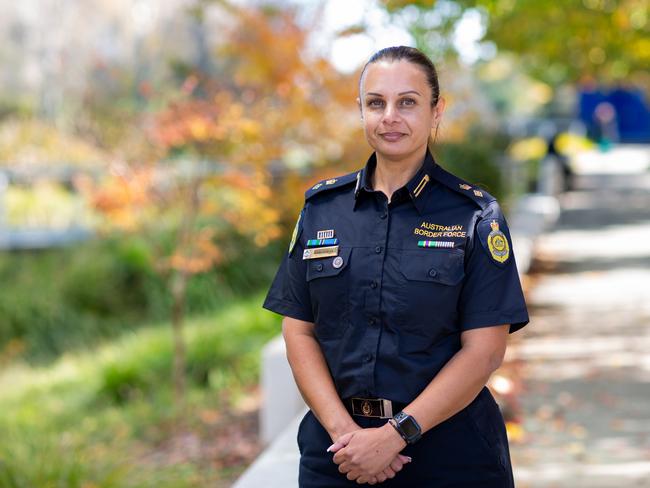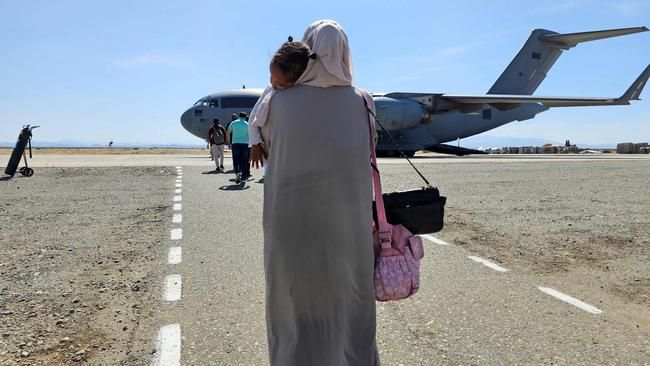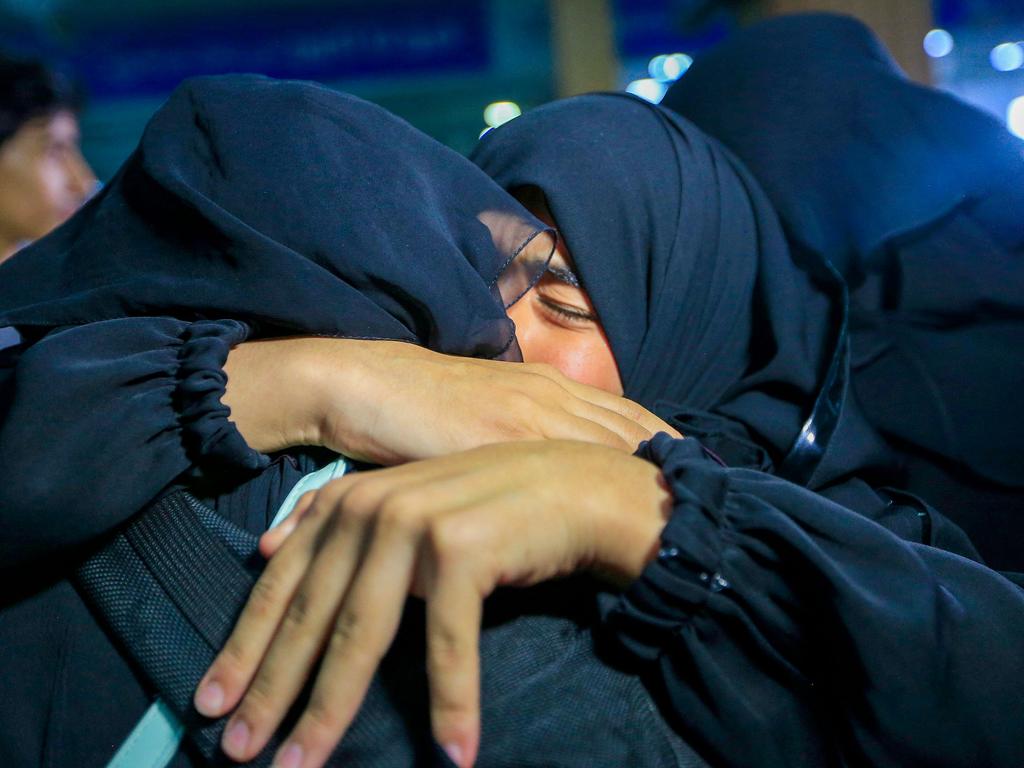Despair, tears and relief: Inside the mission to rescue Australians fleeing the war in Sudan
Families were airlifted to safety in Cyprus as Australia rallied to rescue its citizens and family members in a dramatic evacuation from war-torn Sudan.

As the Royal Australian Air Force Hercules accelerated down the runway of the Port Sudan International Airport, silence fell among the scores of people crammed into its few seats and sitting on the floor.
Behind them their homeland, Sudan, rived by armed conflict and too dangerous for them to stay. Ahead of them Cyprus, where they’d catch commercial fights to safety in Australia.
Mary Greiss was one of those sitting on the cold steel floor when the family sitting in front of her noticed her high-visibility Australian Border Force vest.
“The mother turned around to me and said: ‘I’m so proud and thankful for the Australians and all the work they’ve done considering the situation,’ ’’ Greiss recalls.
“She gave me a huge hug and her husband gave me a handshake and the kids were high-fiving and fist-bumping. And that made me feel really proud, to see them smiling and happy. The relief, knowing they were going to be safe.’’
The family was among 153 Australians, family members and foreign nationals evacuated on two RAAF mercy flights out of Sudan to Cyprus early this month.
The decision by foreign nations to evacuate their citizens came as open warfare between rival factions in Sudan’s military regime exploded suddenly last month, displacing tens of thousands of civilians and leaving hundreds dead or wounded.
As the fighting raged in the capital Khartoum, a seven-day ceasefire was negotiated to allow foreign military and civilian aircraft briefly to enter Sudan to repatriate their citizens.
Australia was one of the countries that set up base at the Joint Rescue Co-ordination Centre in Cyprus, an operating base usually used by European nations to monitor and respond to migrant boats crossing the Mediterranean. On this occasion it was being used to co-ordinate rescue efforts, with citizens from Britain, the US, Canada, New Zealand, Sweden, Switzerland, The Netherlands and Ireland joining the Australians on the RAAF flights.

The evacuation, led by the Department of Foreign Affairs and Trade, included the Australian Defence Force and 74 officials from Home Affairs and the Australian Border Force.
Greiss, an Arabic-speaking ABF superintendent based in Sydney, was one of a small group deployed into Sudan to help bring our citizens home.
Exhausted, teary, and often carrying nothing but a bag of nappies and a change of clothes, Australian-Sudanese families arrived at the Port Sudan airport by bus where they were met by Greiss and her colleagues, who processed their paperwork and made sure there were no impediments to them returning to Australia.
“There were more women and children than there were men,’’ Greiss recalls.
“Women had three or four children with them. English wasn’t the first language for some of them.
“There were some nurses, a couple of doctors and people who would be able to support some of the others. We met them with warmth and compassion because we could see the despair and the tears, we could see the emotion.’’
Many who had fled the fighting with little more than the clothes on their back had taken days to make it to Port Sudan. Greiss, whose usual job with the ABF is removing unlawful non-citizens from Australia, recalled the relief on the faces of those as they met the Australian officials.
“One woman I spoke to mentioned that she had travelled about four days by land from Khartoum. She had three children, she was nursing a baby, and she was very relieved to see us.’’

Once on board the Hercules for the flight to Larnaca Airport, in the Greek-controlled side of Cyprus, the families were given water and ADF ration packs, and they were accommodated in Larnaca until they could be placed on commercial flights home.
Greiss, 45, was on the second flight out of Port Sudan on May 4.
“On the way back we were on the floor. We left the seats for the vulnerable; we had a lot of elderly, we had a blind person, we had women with nursing babies so we made sure those seats were available for them.
“All the little kids were on the floor. Some of them had a lot of energy, which was good to see, they were crawling across the floor and trying to keep themselves occupied for the four-hour flight.’’
Greiss says the plane fell silent as it lifted off from Port Sudan. But arriving into Larnaca, spontaneous applause broke out as the plane touched safely down. “We’d had limited food and limited water but our motivation was just to get the Australians who wanted to leave, identify them and get them out as quickly as possible,’’ Greiss says.
“It was a huge relief because obviously there are so many unknowns and there is always going to be a risk involved in any of these types of missions or settings.’’

Port Sudan is a busy transport hub on Sudan’s east coast, and the city to which people fled when violence exploded on April 15 with deadly clashes in Khartoum and Darfur between the Sudan Armed Forces loyal to Sudan’s de facto leader, General Abdel Fattah al-Burhan, and a paramilitary umbrella group known as the Rapid Support Forces, which supports General Mohamed Hamdan Dagalo, a former war lord known as Hemedti. As up to 100,000 people fled the fighting, thousands of foreigners were taken out on emergency flights with countries including Britain and Australia flying to Cyprus, while France took 1000 French, American, British, Italian and Swedish citizens out via Djibouti. The US organised bus convoys for its citizens from Khartoum to Port Sudan, monitored by armed drones, and helped more than 1000 American citizens out via ferry across the Red Sea to Jeddah in Saudi Arabia.
Crowds had gathered at the gates to the Port Sudan airport, but in far fewer numbers than the tens of thousands of desperate people who flooded the perimeter wall at the Hamid Karzai Airport in Kabul when the Taliban swept to power in August 2021 in Afghanistan.
In one of the world’s largest airlift operations, 122,000 people were evacuated from the airport following the collapse of the NATO-backed Afghanistan government. Across nine days, Australia airlifted 4100 people on 32 evacuation flights to the United Arab Emirates.
On August 26, hours after Australia pulled out of Afghanistan, an Islamic State suicide bomber attacked the crowds still clustered around the airport, killing 170 Afghan civilians and 13 US military personnel.
Greiss, and one of her colleagues in Sudan, ABF chief superintendent Neil Horne, had been deployed to the UAE to help with processing the Australians who were rescued from Afghanistan, and were well aware of the risks involved in such operations.
Horne, whose usual role with the ABF in Canberra is running the offshore disruption branch, says officials had been keeping a close eye on the deteriorating security situation in Sudan, with whole-of-government meetings to plan the evacuation.

“There were meetings about every 24-48 hours depending on what was happening,’’ he says. “We first forward-deployed to Larnaka in Cyprus, which is where the Australian contingent was going to operate out of for the operation. It’s called the Zenon Centre, it’s a Cypriot government facility, basically a large office space that allows for people to have side meetings and co-ordination and be able to walk from one country’s desks to another country’s desks.’’
The RAAF eventually conducted two mercy missions out of Sudan, on May 2 and May 4. Horne, 40, was on both flights.
“At Port Sudan DFAT took the lead on negotiations there with the airport authorities,’’ he recalls. “There were a lot of people who were ready and looking to leave. They had come from all over Sudan. There were a lot of people who were highly emotional, a combination of both upset and quite stressed about what was going to happen to them, and what had occurred to them. In both scenarios there were a lot of tears.
“But there was also overwhelming gratitude, I think, that we were helping them, and there were people in a position to help them.’’
While Port Sudan is 800km and 12 hours’ driving from Khartoum in normal times, many of those who turned up at the airport with just their passports and a change of clothes had spent up to four days making the difficult and dangerous journey. There were endless checkpoints, highly visible armed forces and armed militias, and basic services were shutting down.
And while much of the evacuation was conducted discreetly without media attention, many of the world’s largest militaries were actively involved in evacuating foreign citizens.
American and British warships were stationed off the coast. British paratroopers and US Navy SEALs were reported to have been involved in some of the evacuations.

Australia did not have an embassy in Sudan but sent extra consular officials to embassies in Djibouti, Jeddah, Cyprus and Cairo.
Horne says many of those who climbed off the buses at the airport were exhausted and had spent days travelling to get there.
“Despite their emotion they were also able to show they were very thankful for our assistance,’’ he says. “There were many, many kids. Many small babies, mums with two or three children at various ages from pretty much a newborn up to early teens.’’
Horne, the ABF team leader in Sudan, says the aim was to get people through the airport and into the air as soon as possible.
“For the first flight we did five hours of processing and seven hours in total (on the ground). On the second flight we probably did seven hours of processing and nine hours in total on the ground.’’
He says the Sudanese authorities were working in co-operation with the foreign nations, a number of which had aircraft flying in and out of the airport, and that it was a different environment to the Afghanistan evacuation.
“In the Kabul situation, that was an allied-controlled airfield and the risk of active conflict was quite alive,’’ he says.
“Within this scenario the Sudanese were not in any way combative with us, they merely controlled the airfield and it was their location. We were there in a more co-operative sense, working to their rules and with their permission.
“There were quite a lot of Sudanese authorities around, both military, police and security who were trying to maintain the safety of their airfield with a range of aircraft flying into their location.
“There were many soldiers and police officers around but it wasn’t that same unpredictable threat.’’
Horne says he felt a sense of relief and satisfaction as the final flight took off safely from Port Sudan: “Both from an ABF perspective and an Australian and human being perspective as well, you’re legitimately helping people who need help and it’s an incredibly rewarding feeling.’’
The Department of Home Affairs’ community liaison network has continued to work with the Sudanese community in Australia in the weeks since the evacuation, and immigration officers are still receiving and processing visas for others seeking to leave Sudan.








To join the conversation, please log in. Don't have an account? Register
Join the conversation, you are commenting as Logout